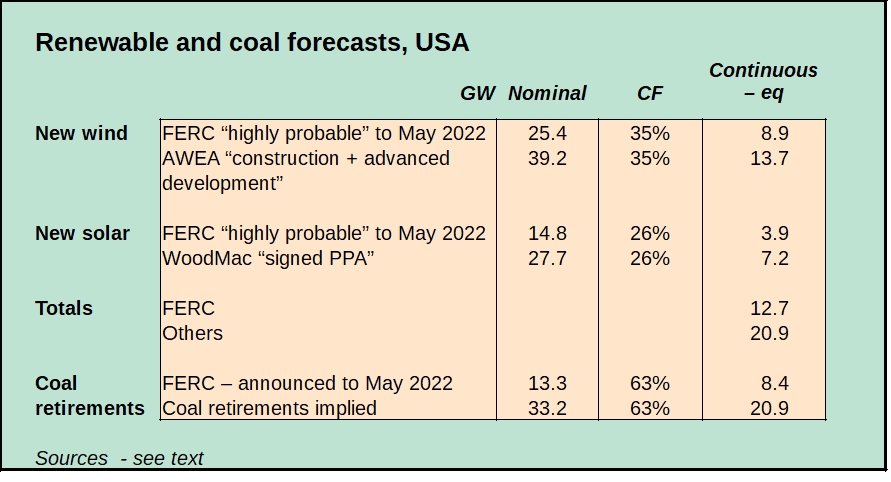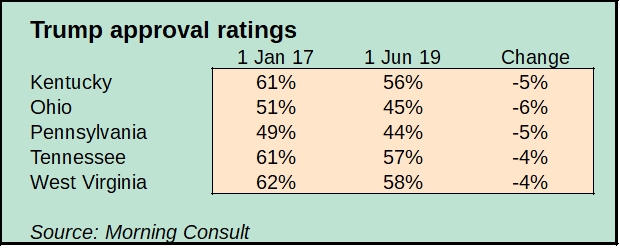The US coal collapse is speeding up as predicted.
Previous posts in this series: Donald Trump’s War on Coal , Trump’s War on Coal II
In January I looked at the state of US coal and concluded:
It is highly probable that demand for coal will fall by the order of magnitude implied by the FERC data. My prediction is that the pace of closures, and the loss of mining jobs, will roughly triple.
I did not predict that it would happen so fast.
FERC regularly updates a table including planned retirements of coal generating plants up to three years ahead. The April table gave 13,992 MW. In May this rose to 17,054 MW: an increase of 3 GW in one month, just over 1% of the remaining capacity.
It’s technically possible, given the rolling horizon, that these 3 GW were already in the spreadsheet for May 2022 and the forecast has just caught up. This is very unlikely, and makes little difference even if it were true.
The
obvious interpretation is that utility executives across the United
States have concluded:
1.
Their coal plants are increasingly uneconomic compared for gas,
renewables, and storage, and carry growing reputational and policy
risks at federal (>2020) and state level.
2. The Trump Administration’s policy to save coal is a sham. Even rhetorically, it is disappearing: Trump did not mention coal in his lastest set-pieces on energy (July 8 remarks, fact sheet).
3.
They might as well bite the bullet now. Nothing will get better for
coal.
The information the utilities supply on closures to FERC, the federal agency responsible for the reliability of the national electricity supply, must be hard. These aren’t predictions but decisions. There is more of the same they are still mulling over. And once they have decided to close a plant, there are pressures to bring the date forward. The collapse will go on speeding up.
With oversight from Washington in the hands of feckless, inept and amoral ex-lobbyists, the end of coal mining in America is coming at an appalling social cost. David Roberts at Vox documents one example, the Eagle Butte and Belle Ayr mines in Wyoming. The short version:
1.
The mines were run by Alpha
Natural Resources. Alpha made
a very bad
bet on Appalachian coal and declared
Chapter
11 bankruptcy in 2015.
2. Te restructuring involved abandoning critical health benefits to 4,580 non-union miners and spouses, slashing the cleanup liabilities, multi-million dollar bonuses to executives, and spinning off the mines.
3.
The buyer of the two
mines was Blackjewel, run by
an Appalachian grifter called Jeff Hoops. Hoops had apparently no
plan to nurse the mines back to viability. Instead he milked the cash
flow for more insider bonuses
while not paying taxes and other creditors. IANAL but it looks to me
like a classic long-firm fraud.
4. Blackjewel suddenly collapsed two weeks ago in a cloud of bouncing cheques, some for wages. It is heading for Chapter 7 bankruptcy and a full liquidation. The state will be left with the uncovered cleanup liabilities, and support for the abandoned miners, assuming they are nor just left to cough their lungs out untreated in the rugged Western way.
5. Roberts does not go into this, but I assume that the political influence of Philip Anschutz, the wind baron of Wyoming, has been strengthened by the fiasco. Wyoming will be less helpful in future to his coal rivals. The state may even go after Mr. Hoops. Good hunting.
PS: let me advertise an old proposal I made here in 2010: nationalize coal. It really is the most humane way to manage the rundown of an entire sector in the public interest. US coal companies are to a first approximation worthless, once you include the cleanup, pension and health liabilities they are trying to evade. So the fair price to shareholders is $0 a share. Bondholders and unsecured creditors? How about their taking the same haircut they are getting anyway under Chapter 11 bankruptcy? The taxpayer will be on the hook for the shortfall in the funds for cleanup, pensions and health, but that’s inevitable in any scenario. What nationalization saves is the looting by the likes of Mr. Hoop, and it allows for proper planning of the reconversion measures.
Socialism? Sure. That’s what makes my proposal sadly unrealistic. Do you have a better one?


